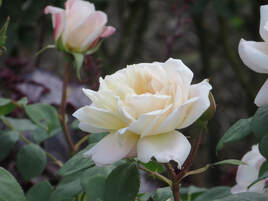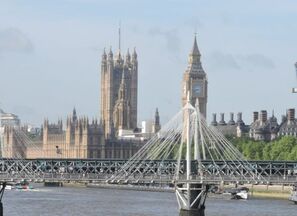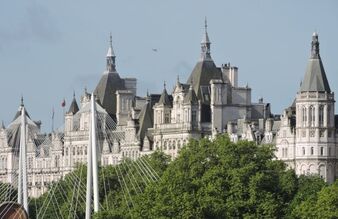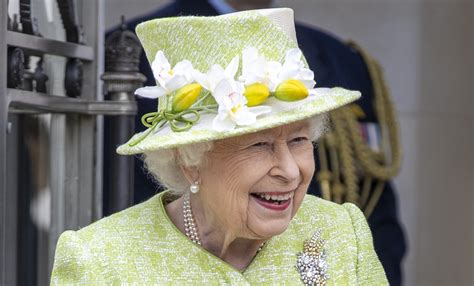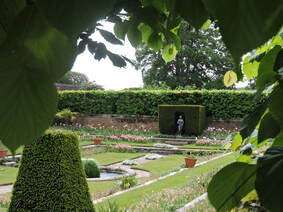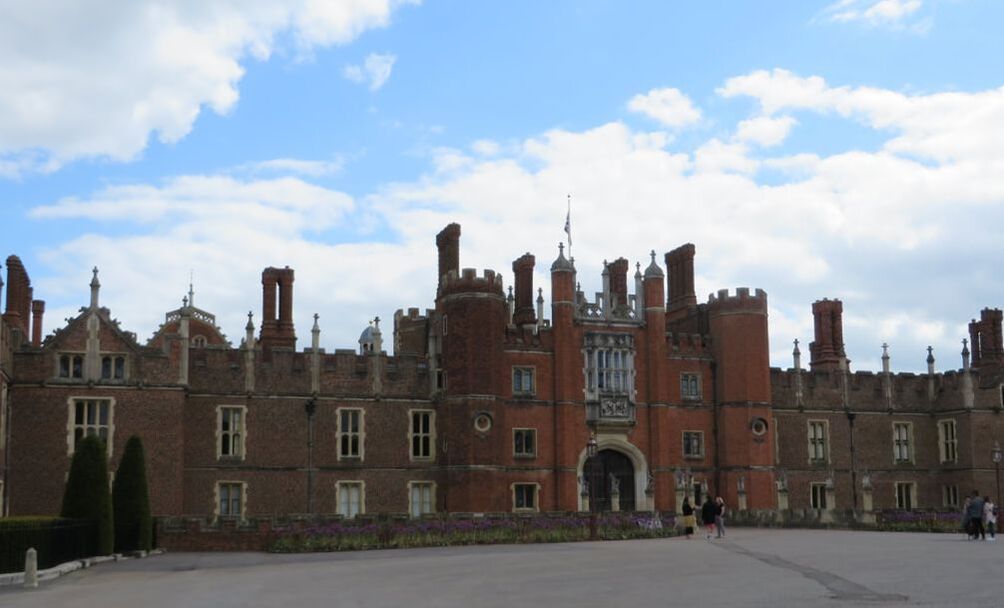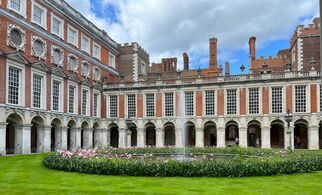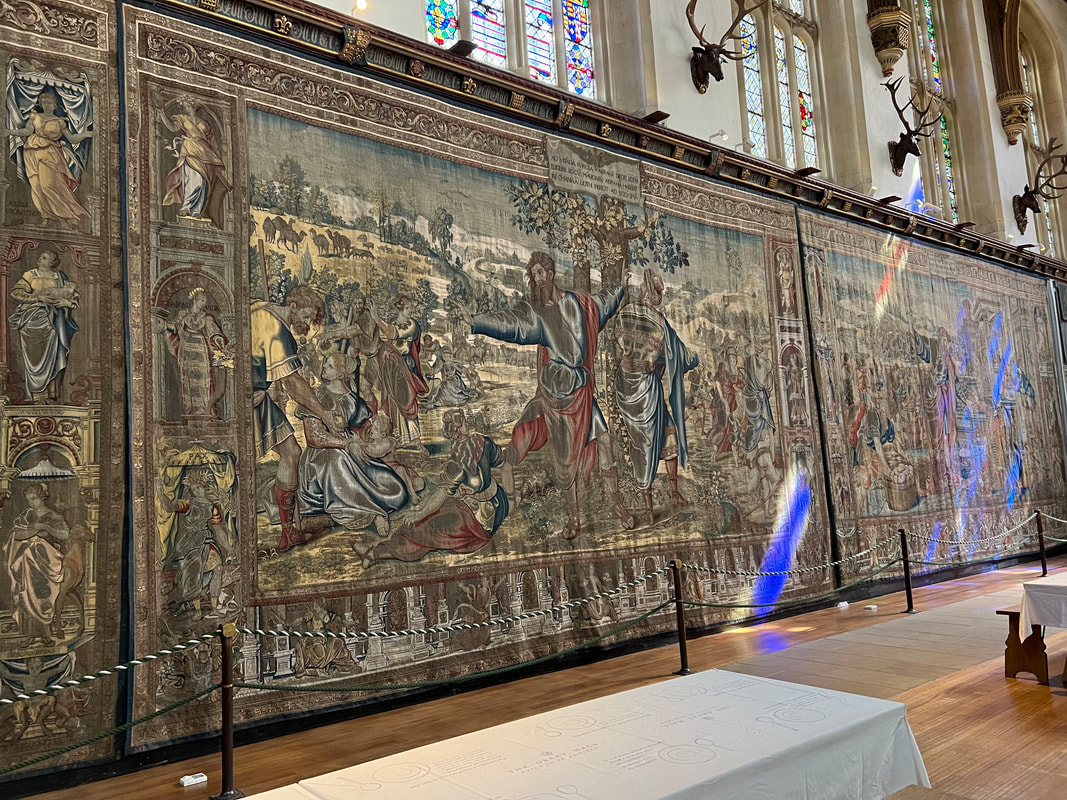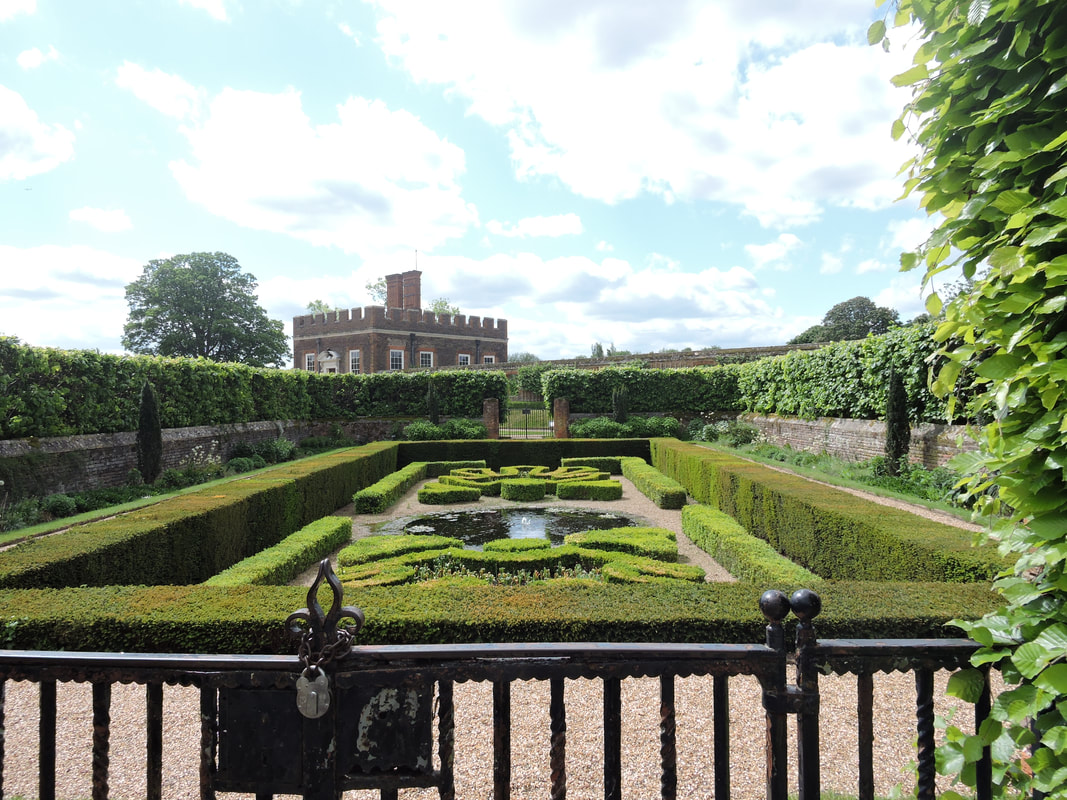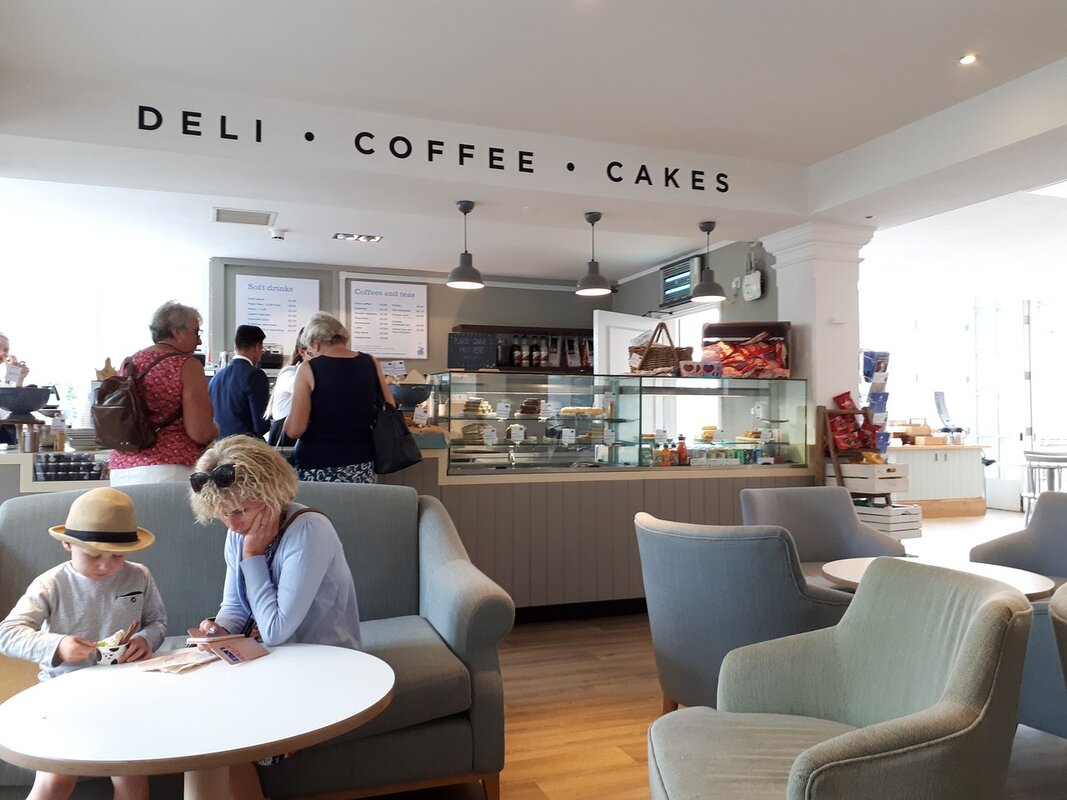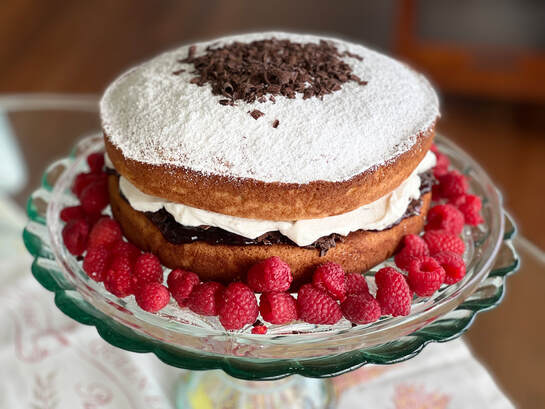|
Asking
Here herons stand silent |
Queen Elizabeth II of the United Kingdom, whose grandmother, Queen Victoria, was friends with Queen Liliuokalani, officially owns seven royal residences, the most famous of which is Buckingham Palace, right in the center of London, near three of the other most famous and oldest monuments in the city—the Palace of Westminster, now known as the Houses of Parliament, built one thousand years ago by King William II, Westminster Abbey, where all of England’s monarchs since William the Conqueror in 1066, have been crowned, and Big Ben, the iconic chiming clock tower added to Westminster Palace in 1859. All of these old and architecturally fascinating palaces can be viewed easily simply by hiring a cab to drive you around central London, taking one of the red tour buses or by walking there yourself if you are staying nearby. The Savoy Hotel, where we stayed and enjoyed Afternoon Tea, is within walking distance of all of these London Landmarks.
Getting to know Hampton Court is an adventure filled with art, beauty, glorious gardens, treachery and intrigue. This magnificent red brick residence spans the Medieval, Tudor and Baroque periods and is still filled with priceless art treasures from these historic eras. The remains of a house built some time before 1338 lie beneath the current palace. This original home was part of a large farm estate belonging to a religious order, the Knights Hospitallers of St. John, who helped provide food and funds for crusaders to the Holy Land. Later, Giles Daubeney, a courtier in the service of King Henry VII, leased the property in 1494 and began construction on the earliest parts of the palace. Now the intrigue begins.
Cardinal Woolsey was also a great admirer and collector of tapestries, one of the most significant and most expensive art forms of the late Medieval and early Renaissance period, the time when the Tudor family came to power in England. Woolsey commissioned around six hundred large wall-hanging tapestries depicting religious and classical themes, some inspired by the poet Petrarch. And he even instructed the weavers to include his own likeness and that of Henry VIII in some of the scenes in the tapestries he purchased. These masterpieces were based on Italian designs and created in Flanders, where this art form flourished, and it was from Cardinal Woolsey that Henry VIII developed his own passion for tapestries, commissioning over two thousand by the time of his death in 1547. Today only thirty tapestries remain from this magnificent collection, once the largest in the world, but many of these exquisite and complex works of art are still hanging on the walls in Hampton Court readily visible to visitors.
Sadly for Cardinal Woolsey, Henry, once an attractive and athletic young man, became a narcissistic and power-mad tyrant later in life. In his youth, Henry never expected to be king, as his older brother, Arthur, was crown prince. However, Arthur died at the age of fifteen, shortly after having married Catherine of Aragon. Henry’s father, Henry VII, died in 1509, and his son became Henry VIII at the age of seventeen. Shortly after his coronation, Henry married his brother’s widow, and they remained married for twenty-four years, but in middle age, Henry became obsessed with the fact that Catherine did not give birth to a son who could succeed Henry as king. Henry wanted to divorce Catherine, and the job fell upon Cardinal Woolsey to convince Pope Clement VII to grant Henry a divorce. Woolsey’s efforts failed, and Henry retaliated by trying Woolsey for treason and confiscating his magnificent palace, Hampton Court, and all of its contents.
Henry solved his marital problem by separating England from the Roman Catholic Church and appointing himself head of the Church of England. He then was free to marry five more women in short succession, two of whom he had executed, and ironically none of them produced a male heir who lived into adulthood. Two of his daughters, Mary his daughter with Catherine of Aragon and Elizabeth, his daughter with his second wife, Anne Boleyn, (whom he had decapitated), went on to become Queens of England. Visitors at Hampton Court can see first-hand, the details of Henry’s self-indulgent lifestyle. The tour of his large kitchens and wine storage areas is breathtaking, as the amount of food that Henry and his courtiers consumed daily is almost beyond belief. Historians have surmised that Henry ate five thousand calories of food, mostly various forms of meat and poultry, daily and imbibed copious amounts of wine. Not surprisingly, Henry became obese as he aged and was no longer able to participate in dangerous martial sports like jousting and tournaments, so he turned to tennis and had an indoor tennis court built for himself. Tourists are welcome to visit Henry’s tennis court, which was actually in use when we were there.
Not surprisingly, Hampton Court does have a place to stop for lunch, the Tiltyard Café, near the gardens. This pleasant little place, which has an outdoor terrace, was not overcrowded, and seemed to be occupied mostly by local mothers on an outing with their children. The Tiltyard Café serves tasty sandwiches, coffee and plenty of tea-time sweets, including pastries, cookies, muffins and cake. I was delighted to spy a beautiful, freshly baked Victoria Sponge Cake, just waiting to be cut and served with a nice hot cup of tea.
You can read all about Victoria Sponge Cake, named for Queen Victoria, (and also loved at tea-time by Queen Elizabeth II), on this website in our Classic British Afternoon Tea menu in the World of Tea Parties section of The Tea Book. And I will share a recipe for Victoria Sponge with you. But first, you will be delighted to learn that as part of the joyfully over-the-top Platinum Jubilee, the Royal Family held a Platinum Jubilee Pudding Contest. Keep in mind, as we learned while watching “Downton Abbey,” that the word “pudding” is used as a generic term in England to refer to any kind of dessert. The winner of the Platinum Jubilee Pudding Contest is a very happy woman named Jemma Melvin, an amateur baker who created a magnificent Lemon Swiss Roll and Amaretti Trifle. Wow!
You can easily find photos and recipes for this masterpiece, as the internet is filled with articles about this exciting event. I downloaded the recipe including a photo of Jemma, holding her trophy, standing between HRH Camilla The Duchess of Cornwall and the charming BBC food hostess and cookbook writer, Mary Berry, who judged the event. Just type in “Platinum Pudding Recipe—The Royal Family,” and you will find the recipe. The steps to creating this innovative but still very traditionally British Trifle include making the following individual components: Swiss Rolls (called Jelly Rolls in the US,) Lemon Curd, St. Clement’s Jelly, Custard, Amaretti Biscuits, Chunky Mandarin Coulis and Jeweled Chocolate Bark. A caveat at the end of the recipe points out that many of these components can be purchased separately, simplifying the process considerably. Our website contains recipes for making Lemon Curd and home-made Custard. I offer a round of applause for any readers who feel inspired to make this new and historically significant dessert to celebrate the Platinum Jubilee at home with your own families.
Meanwhile, as promised, I am happy to share the recipe for Victoria Sponge Cake.
Home bakers who want to make Victoria Sponge should feel free to vary the filling based on their own preferences and the season of the year. For example, whipped cream might not be the best choice for a Fourth of July outdoor picnic, as it is likely to melt, causing unsightly slippage. However, one could create a lovely Victoria Sponge for an American Independence Day celebration by spreading a layer of buttercream icing over the bottom layer, topping it with fresh blueberries and raspberries, sifting pure white powdered sugar on top of the cake, and surrounding it with additional raspberries and blueberries, providing the traditional red, white and blue effect. I have provided a simple recipe for Buttercream Icing for anyone who prefers not to use Whipped Cream. Since I love fresh cherries, and they should still be available in July, I am including cherries and dark chocolate shavings in this simple, recipe for Victoria Sponge Cake, adapted from Zoe Bakes Cakes. Please note that this recipe calls for self-rising flour and superfine sugar, both easily available at the supermarket. My final caveat for the hurried, busy (or lazy) baker, is that you can certainly make your Victoria Sponge with a boxed yellow cake mix, such as good old Duncan Hines.
For the cake:
- 1 cup butter at room temperature
- 1 cup plus 2 tablespoons superfine sugar
- 1 tablespoon vanilla extract
- 4 large eggs at room temperature
- 1 ¾ cup self-rising flour
- Baking spray with flour for the pans
For the jam filling:
- ½-1 cup cherry preserves or raspberry jam
- 1 (4-ounce) bar bittersweet chocolate (I used Ghirardelli 60% cacao,) chopped, grated or cut into chocolate curls with a vegetable peeler
For the whipped cream:
- 2 cups chilled heavy whipping cream
- 2 tablespoons powdered sugar
- 1 teaspoon vanilla extract
Alternate butter cream filling instead of whipped cream:
- ½ cup (1 stick) butter, at room temperature
- 2 cups powdered sugar
- 1-2 tablespoons heavy cream
- ½ teaspoon vanilla extract
For serving and garnish:
- Powdered sugar
- Fresh cherries or raspberries
- Additional chocolate curls
Preheat oven to 350 degrees F
Special equipment:
2 nine-inch round cake pans, parchment, large mixing bowl, medium mixing bowl, hand-held electric mixer, rubber spatula, table knife or offset spatula, food processor or vegetable peeler, wire cooling racks, wooden skewer, sieve, decorative platter or cake stand
Serves: approximately 12 servings
- Spray the cake pans with baking spray with flour. Cover the bottoms of both pans with two layers of parchment cut to fit, and spray again.
- Measure the self-rising flour into a medium sized mixing bowl and set aside. Beat the butter in a large mixing bowl with an electric mixer, on high speed until creamy and smooth, about 1 minute scraping the sides as needed. Turn the mixer speed to medium low and add the super-fine sugar and vanilla until thoroughly mixed. Then turn the speed to medium high and beat the mixture until very light and fluffy, about 5 minutes, scraping the bowl often.
- Turn the mixer speed back to low and add the eggs, 1 at a time, and beat just until incorporated, scraping the bowl after each addition.
- Add one third of the flour mixture and mix on low just until no flour is visible. Add the remaining flour in two additions, just until incorporated each time, scraping the bowl. The batter will be thick.
- Divide the batter equally between the 2 prepared pans, and carefully smooth the tops of the batter with a kitchen knife or an offset spatula. Gently tap the pans on the counter to release air bubbles. Bake for about 20 minutes until the cakes are golden and a wooden skewer inserted into the center comes out clean. Cool on wire racks for 15 minutes. Remove the cakes from the pans, peel off the parchment and allow the cake layers to cool completely on wire racks, about 30-60 minutes.
- While the cakes cool, prepare the whipped cream or alternate butter cream filling. Wash the large mixing bowl and the electric mixer beaters, dry them carefully and chill them for a few minutes in the freezer. Add the chilled heavy cream to the mixing bowl and beat on medium speed until soft peaks start to form. Add the powdered sugar and vanilla and continue beating until the cream becomes firm and holds it shape, 2 or 3 minutes. Refrigerate immediately.
- To make the alternate butter cream filling, add the butter and powdered sugar to the medium sized mixing bowl and beat until fluffy and well combined. Add the vanilla and 1 tablespoon of cream. If the mixture is too thick to spread, add 1 or more additional tablespoons of cream until the filling is a good spreading consistency. Set aside until ready to assemble the Victoria Sponge Cake.
- Assemble the cake shortly before serving time. Save the best shaped of the 2 cake layers for the top and place the other layer, top side down on a decorative platter or cake pedestal. If using whipped cream, stir the cherry preserves or raspberry jam and spread a layer evenly over the top and to the edges of the cake. Sprinkle some of the chopped chocolate (or chocolate curls) over the jam, saving some for garnish. Spread a one-inch layer of whipped cream over the jam and chocolate layer and carefully place the second cake layer over the top of the whipped cream, aligning the sides of the two cake layers. Press very gently to adhere. Using a sieve, sift a generous layer of powdered sugar over the top, sprinkle the remaining chocolate curls in the center, scatter fresh cherries (or raspberries) around the cake, and serve immediately with any remaining whipped cream, berries or cherries.
- If using the butter cream filling, spread the butter cream over the top of the bottom cake layer first, and then spread the jam and chocolate curls carefully over the butter cream. Proceed as described above by adding the top layer, sifting powdered sugar over the top of the cake and garnishing with the remaining chocolate curls. Scatter fresh cherries and or raspberries around the cake and serve immediately. Refrigerate any leftovers.
